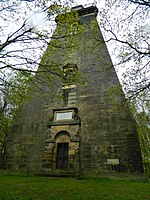The Rockingham Mausoleum
Buildings and structures in the Metropolitan Borough of RotherhamGrade I listed buildings in South YorkshireMausoleums in EnglandWentworth, South Yorkshire

The Rockingham Mausoleum, Wentworth, near Rotherham, South Yorkshire, England is a cenotaph commemorating Charles Watson-Wentworth, 2nd Marquess of Rockingham, who was Prime Minister at the time of his death in 1782. The name by which the memorial is now known is in fact a misnomer, since Charles Watson-Wentworth is buried in York Minster. Eighteenth and nineteenth century sources refer to the edifice simply as "the Monument".
Excerpt from the Wikipedia article The Rockingham Mausoleum (License: CC BY-SA 3.0, Authors, Images).The Rockingham Mausoleum
Cortworth Lane,
Geographical coordinates (GPS) Address External links Nearby Places Show on map
Geographical coordinates (GPS)
| Latitude | Longitude |
|---|---|
| N 53.4684 ° | E -1.3785 ° |
Address
The Rockingham Mausoleum
Cortworth Lane
S62 7SA
England, United Kingdom
Open on Google Maps






